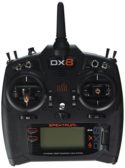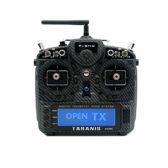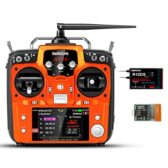The Best RC Transmitter for Drones in 2021
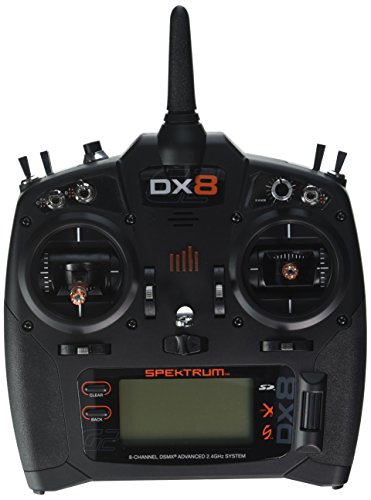
Spektrum DX8
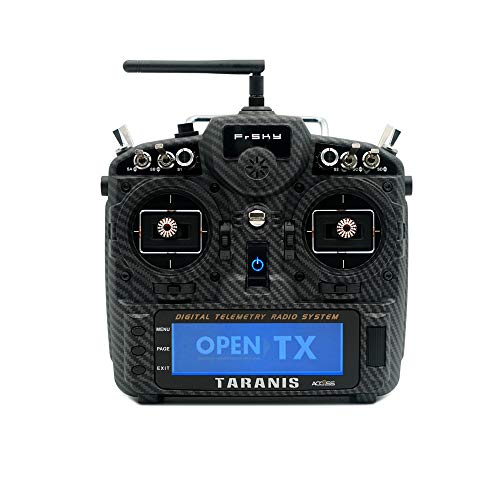
FrSky Taranis X9D Plus SE 2019
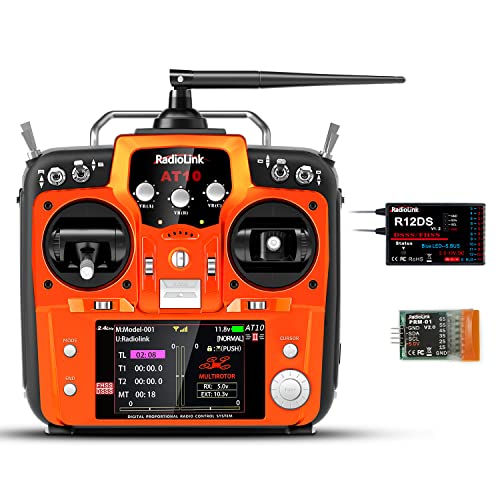
Radiolink AT10II
A drone is only as good as its pilot. In a way, this is true. How your drone performs depends much on your skill and performance.
But one piece of equipment that can influence that more than anything else is the drone transmitter. This is your main communications link with your drone, so you need it to be working as flawlessly as possible.
Those looking for an RC transmitter for a drone are usually doing so because they are serious about their flight performance — whether this is for commercial or recreational use, it doesn’t really matter.
Your potential is only limited by the quality of your drone and the quality of the transmitter.
We’ll start by giving you recommendations for the best transmitter out there, and then we’ll guide you through the key things you need to be looking for when you’re on the hunt for the perfect controller for you.
When Should You Get A Drone Transmitter?
The majority of drones available in the market today would already have a drone transmitter included. These Ready To Fly (RTF) drones save you the money and effort from having to buy a separate one.
Even if it doesn’t have a transmitter included, most would support using your smartphone as the drone remote controller.
But these included transmitters are very much focused at beginner flyers — usually, at least — keeping them very simple and focusing on fun and phone support.
Most people who buy separate drone transmitters are tinkerers building their own drones, either from scratch or via a kit, or are more serious flyers.
Nevertheless, there are still advantages of buying a drone transmitter even if you have an RTF drone. A lot of the transmitters that are bundled with them are “stock units” with very basic functions. At best, they’re inferior in quality.
Because third-party RC transmitters are usually of higher quality, getting one of them is a solid investment.
You’d want to buy one for the added channels and model memory.
The former allows you to control more functions on your drone. At the same time, the latter enables you to manage multiple drones with a single transmitter (no, not at the same time!).
They’re also commonly paired with FPV goggles in order to retain FPV functionalities of your crafts.
The Best RC Transmitters 2021
We may receive compensation on qualifying purchases via our links. This does not change how we review items. For more information, please read our affiliate disclosure.
The Spektrum DX8 is a powerful 2.4 GHz transmitter that has all the features a pilot could ever want in a controller.

- Channels: 8
- Model Memory: 250
- Battery: NiMH battery included
- Weight: 1.8 kg
- Dimensions: 12 x 9.3 x 5.5 inches
Despite it only having 8 channels, you’ll get a lot of value out of the DX8.
Like other Spektrum transmitters, this is a hobby-grade controller that can be used at competition levels. You get an ultra-responsive radio transmitter, that does a fantastic job at maneuvering anything from a drone to an RC car. You get a rapid response rates of just 11ms.
But that’s just the basics – most transmitters can do that. The bonus you get with the DX8 is in the added functionality it brings to the table.
One highlight is the programmable voice prompts, which you can program alerts, warnings, and other reporting of your drone. It’s completely customizable, such that you can tell it to verbally inform you if battery levels or altitude reach threshold limits, for example.
The programmable voice prompt is so useful that you can pretty much rely on this feature alone to tell you all the vital info you need to know while piloting. If you’re a racer who wants to keep an eye on the track at all times, this is just perfect.
The DX8 is also a highly programmable transmitter, which you can use to control a plethora of RC vehicles and drones. This is coupled with the massive 250 model memory of the DX8. Plus, you can share profiles onto other Spektrum transmitters via the AirWare software.
The Wireless Trainer Link feature also allows you to link and use another DSM2/DSMX transmitter simultaneously with the DX8. With this setup, you can, for example, control the camera gimbal with the DX8 while another transmitter pilots the drone. It enables two-person piloting for more focused control.
The only limitation of the DX8 is that it only has 8 channels. But as we mentioned, 8 is already plenty for most users.
Despite this, the Spektrum DX8 is still an excellent transmitter to get. It has a robust voice prompt system, expanded model memory, and trainer link that most pro users will appreciate.
+ Pros
- Cons
The FrSky Taranis X9D PLUS SE is a revamp of the original X9D. If you’re not familiar with the X9D, it’s only the most popular FPV transmitter ever made.

- Channels: 24
- Model Memory: 60 models (expandable with an SD card)
- Battery: 2S Li-Battery (not included)
- LCD Screen: 212 x 64, monochromatic
- Operating System: OpenTX
- RF Module: ISRM-S-X9
- Receiver Compatibility: ACCST D16 and ACCESS
- Weight: 700g (with no battery)
- Dimensions: 7.8 x 7.6 x 4.3 inches
Dubbed as a “hobbyist transmitter made by hobbyists,” it is an advanced unit chock full of powerful features.
First, the controller shape itself has been modified to make it more ergonomic. There are momentary buttons added on either shoulder, making it easier to access during flight. There’s also a scroll wheel to make navigating the on-screen menu easier.
The X9D PLUS SE uses the new ACCESS protocol, which governs how the transmitter and receiver communicate with each other. This gives several benefits.
First, this expands the X9D+ 2019 SE’s channel count to a whopping 24, giving you much more freedom than ever before. Although we couldn’t imagine how this won’t be enough for some!
It also gives you lower latency and higher baud rate, reducing lags, and improving overall performance and responsiveness. It also makes binding the receiver to the X9D+ SE directly through the transmitter, which is convenient.
The Hall Sensor gimbals used in the X9D+ SE are also noticeably smoother to use than other transmitters. There’s no “click” or resistance throughout the entire range of motion, with even tension all throughout.
The model memory on the X9D+ SE is also generous, allowing you to store up to 60 different profiles. This is even expandable with an SD card. For power users with a bay full of drones, this is the last thing you’ll ever need.
Overall, the Taranis X9D+ SE 2019 is one of the more advanced transmitters out there. But that doesn’t mean a complete newbie will not appreciate it. This is actually a beginner-friendly controller, but with enough advanced features to satisfy any pro.
+ Pros
- Cons
If you’re looking for a nice balance between features and price, the Radiolink AT10-II is your best bet. The mid-range transmitter offers support for 12 channels and telemetry data at an attractive price point.

- Channels: 12
- Range: 4 km (open with no obstacles)
- Battery Life: up to 12 hours with 3s 1800 mAh LiPo battery (not included)
- Dimensions: 7.1 x 3.7 x 8.7 inches
- Weight: 907g
The package includes an R12DS 12CH SBUS/PWM receiver to be installed on your drone. You can also equip it on any RC vehicle or even an RC robot. The receiver also has DSSS and FHSS protocol, which acts as an excellent anti-interference measure. Binding the AT10-II to the receiver is also effortless.
One of the highlights of this drone is its support for telemetry data. The LCD screen display is capable of showing relevant information like voltage, signal strength, battery life, distance, and more. For the price, we find the data range to be excellent.
The control range of this transmitter extends up to 4 km. However, this is considerably less when there are obstacles (like walls) along the way. Still, it’s substantial, and I personally never got to maximizing it to that distance.
Performance-wise, the AT10-II is very responsive. All 12 channels have a response time of 3ms, even when all used simultaneously. In practice, our drone reacted almost instantly to our commands.
We also found the shape of the AT10-II to be ergonomic, which conformed perfectly to our hand. The layout of the button makes everything easily reachable without straining. Oh, and you can specify whether you prefer Mode 1 or 2 when you buy this controller.
The battery life is also something noteworthy with the AT10-II. The underlying power-saving technology of this transmitter allows it to consume only less than 105 mA of power, giving 12 hours of operating time with a modest 1,800 mAh LiPO battery. That’s 50% consumption compared to other transmitters.
With that being said, this isn’t a beginner transmitter. It needs a lot of avionic knowledge to be able to set it up properly. But for DIY drone creators, the Radiolink AT10-II is a fantastic transmitter with a price that’s hard to beat.
+ Pros
- Cons
The FlySky FS-16S is one of the best budget RC transmitters out there. This is because, despite the price, it actually performs pretty well.
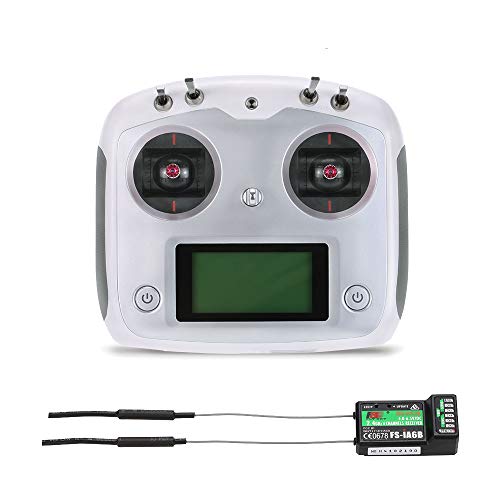
- Channels: 10
- Range: 1 km
- Frequency Range: 2.4 GHz
- Weight: 410g
- Dimensions: 7 x 3.1 x 6.3 inches
To be able to use this cheap RC transmitter, you need to install the included FS-iA6B receiver onto your quadcopter. This might pose a problem with beginners, since doing this requires a fair amount of DIY work. If you’re iffy about it, you can just get someone to do it for you.
The first impression is that the radio quality of the FS-16S is superb, which is comparable to that of a higher-end model. The omnidirectional antenna gave a stable connection and resulted in very responsive flying.
We encountered little to no interference with it (we used it in a reasonably densely populated urban area). This is thanks to FlySky’s patented channel-hopping technology, AFHDS 2A. It allows automatic switching between 140 channels, to get the best possible signal between the receiver and transmitter.
The FS-16S also supports both transmitting and receiving signals from the drone. This allows you to access telemetry data and see crucial drone information mid-flight.
Ergonomics wise, the controller doesn’t have any parts jutting out that can interfere with your grip, which is nice. The gimbals are standard issue and fall somewhere in the middle in terms of smoothness. Unfortunately, this unit offers no easy way to adjust the tension on the gimbals.
The FS-16S also has a fantastic battery life, as this transmitter employs energy-saving features and low power consumption components. In fact, tests show it consumes 90% less power than standard transmitters.
Overall, for a starter transmitter, the FlySky FS-16S delivers. It produces fantastic performance, all while costing less than $60. You might need to tinker a bit with it to install the receiver, but once you do, you’ll be rewarded with a controller that works.
+ Pros
- Cons
No products found.
Not yet ready to invest in a full-blown FrSky model? You can opt to get the Q X7 instead to get a feel for what the Taranis series is capable of.
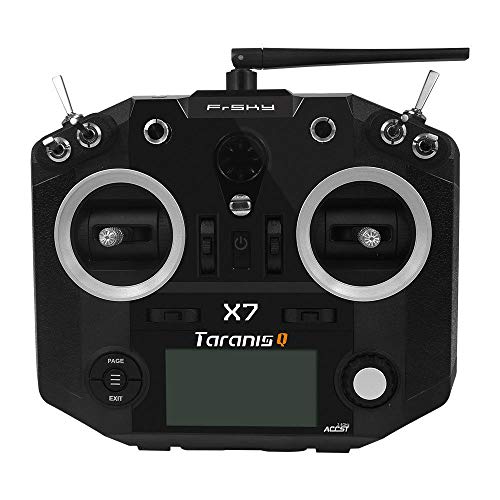
- Channels: 16
- Model Memory: 60
- Operating System: Open TX
- Weight: 997g
- Dimensions: 11 x 9.8 x 4.5 inches
This is a powerful yet lightweight RC transmitter from FrSky. Luckily, it inherits some of the quality and function of its older brothers in the Taranis lineup.
The Q X7 is a 2.4 GHz transmitter that uses FrSky’s proprietary ACCST communication protocol. It gives you 16 channels to play with to handle all of your drone’s flight features. If that’s not enough, the Q X7 also supports up to 32 channels with a FrSky XJT module (sold separately).
The Q X7 shares the same ergonomic design and layout as other Taranis transmitters. The gimbals use a spring mechanism that effortlessly returns to their default position. You can opt to remove this if you prefer a more stationary throttle.
The backlit LCD screen is where the main menu can be accessed. Navigating requires the use of the wheel and center buttons, which is easy enough to use.
One of the highlights of the Q X7 is the amount of data you can extract from your drone using the transmitter. It gives you lots of telemetry data, which is both displayed and logged in real-time.
If you’re going to use an FPV goggle together with this, then you’ll appreciate the audio speech outputs of the Q X7. Voice prompts let you know of any critical alert or setting while flying. Alternatively, you can also utilize the transmitter’s Haptic Vibration Feedback System to alert you of any warnings.
The only downside of the Q X7 (and the one frequently complained by users) is the lack of a built-in battery or battery tray. In fact, there isn’t much info regarding what batteries you need to use with the unit.
Nevertheless, the Taranis Q X7 is a fantastic pick. You’ll get a glimpse of the legendary quality of FrSky transmitters at a fraction of the price. Top-notch performance all in all.
+ Pros
- Cons
No products found.
Taking cues from console controllers, the familiar shape of this FlySky Nirvana NV14 transmitter will be instantly recognizable to any gamer.
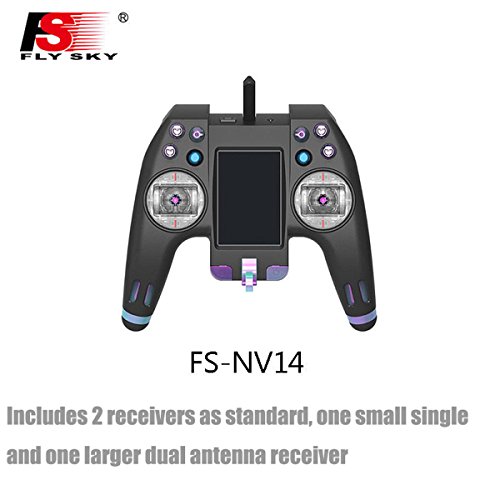
- Channels: 14
- Frequency Range: 2.408 – 2.475 GHz
- Screen: 320 x 480 3.5 inch LED
- Weight: 598g
- Batteries: Two 18650
- Dimensions: 10.1 x 9.2 x 4.5 inches
There’s a reason why game controllers look the way they do – they’re designed to be used for hours without wearing the user down. Adopting this shape makes the NV14 instantly ergonomic and a joy to hold.
Fortunately, the comfort and ease of use go beyond just the shape. The hall gimbals also feel very smooth throughout their range of motion. It doesn’t lock or have any resistance, which makes navigating your drone around effortless. The size of the gimbals also offers a nice balance that’s suitable whether you’re a pincher or a thumber.
The other thing that stands out with the NV14 is the enlarged color touchscreen in the middle of the transmitter. Yup, no need for cumbersome menu wheels or buttons to navigate – just intuitive tapping.
This screen also makes FPV (First Person View) possible with this transmitter. No need to whip out your smartphone and mount it on the controller. Everything is kept compact and seamless.
Powering its features and video transmission is a 32-bit M4 processing system with a 166 MHz SDRAM. This is like having a mini computer at the palm of your hand.
This also makes certain features possible, like a USB HID connection for using it in drone simulations. An optional Bluetooth module is also present for future use.
Overall, the FlySky Nirvana NV14 won us over with its ergonomic shape that is extremely comfortable to use. The LCD touchscreen is also an excellent addition. Most of all, the layout and design of this transmitter are not intimidating at all.
If you’re looking for a transmitter to use with your racing drone, we highly recommend this.
+ Pros
- Cons
The Radiolink T8S is the perfect RC transmitter for children. It is a good reason to swap if your toy drone doesn’t have a quality controller bundled with it.
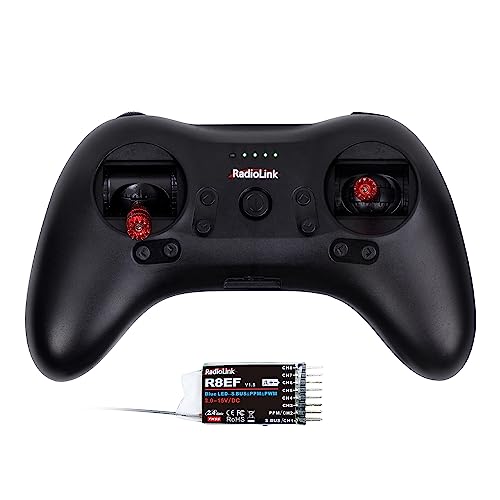
- Channels: 8
- Range: 2 km (with no obstacles)
- Weight: 141g
- Battery Life: 5 hours from built-in 900 mAh 1S Lithium battery
- Compatibility: Radiolink R8EF, R8FM, R8F, R6FG, R7FG, and R4FGM receivers
- Dimensions: 6.37 x 3.76 x 2.24 inches
The T8S is shaped like a console game controller, but without the finger grip. The small form factor makes it suitable for a child’s hand, as everything is easily reachable without straining. It also makes the T8S very portable, even when stowed in your kid’s pockets.
The control layout is also simplified, so as not to make it too overwhelming for a kid. The gimbals glide smoothly without much effort. The gimbals are even removable.
With that being said, most users would find the channels (at just 8) and buttons available on this transmitter to be lacking.
Talking about the performance of the T8S, it’s a pretty responsive transmitter despite it being an entry-level model. FHSS technology lends it some anti-interference, as our own personal tests show.
Another good thing about the T8S is that it already has a rechargeable battery built-in, unlike most transmitters you’ll encounter. This gives you 5 hours of operating time, which is plenty enough for multiple runs with your drone. Charging can be done conveniently via the USB port.
Since it doesn’t come with its own receiver, it relies on an existing one on your drone. On the plus side, this makes pairing the T8S to the receiver rather easy. On the other hand, you’ll be limited by the drones that you can use with this transmitter.
Adjusting settings and parameters on the T8S is done using a smartphone app. You simply connect it via the USB port on the transmitter. Software upgrades can also be done through this procedure.
All in all, the Radiolink T8S is an excellent upgrade to supplement your toy or hobby drone. It’s easy to use, and setup, plus the ergonomic design will be appreciated by your kids.
+ Pros
- Cons
What to Look for in an RC Transmitter
Learning how to pick the best drone transmitter can be a daunting task, especially for a newbie. There’s a wide variety of specs and features among the many different price tiers that can quickly overwhelm anyone.
But it’s really straightforward as long as you know what you’re buying. Here are a few considerations you need to make before getting one:
Channels
One of the most critical factors you need to make is how many channels your transmitter will have. This is crucial since it will govern how much control you can have over your drone.
Let me explain.
A channel is basically a specific frequency the transmitter and receiver use to communicate with each other. Think of this as individual “invisible wires” that connect your transmitter and drone.
Now each “wire” or frequency governs one aspect of your drone’s movement. For instance, one channel controls the left and right movement of your drone, while another channel is for throttling.
Since a drone has 4 different kinds of movements, you need a minimum of four channels to be able to successfully pilot one. That’s why most transmitters have around 4 – 9 channels on average.
Each channel is “tied” to a particular button or axis on your controller. So, for example, tilting your joystick to the right triggers one specific channel and its corresponding movement.
Clear so far? Good.
Now, if you have more than 4 channels, you can use the excess to control many different aspects of your drone. For example, you can assign the Return to Home function to the 5th channel and a button, so that the feature is triggered when you press it.
So having lots of channels will give you lots of button “shortcuts” to access critical commands on your drone. Overall, this makes it easier to pilot on your end.
Our recommendation is to get at least 6 channels on your transmitter and aim for the maximum of 9 if possible. Even if you don’t need it yet, you’ll future-proof yourself in case you need additional channels if you build a new drone down the line. Of course, more channels are more expensive.
Frequency
We discussed above how transmitters and receivers communicate with each other through specific channels. These channels, in turn, operate on specific frequencies.
Drones can operate in frequency ranges from 900 MHz up to 5.8 GHz, but the most common ones in use are 2.4 GHz and 5.8 GHz. Between the two, you have to decide based on your particular needs. Each frequency has its own properties and advantages/disadvantages.
Higher frequencies, for instance, tend to travel in shorter distances, but have much bigger bandwidth, making them suitable for substantial data like video transmissions. Lower frequencies, on the other hand, go farther and faster through obstacles but have much lower bandwidths.
When it comes to controlling your drone, the most commonly used frequency is 2.4 GHz. This is because the relatively simple commands require little bandwidth, and they benefit from the more extended range 2.4 GHz gives. It’s also reasonably compact.
The main issue with 2.4 GHz, however, is interference. That’s because a lot of other wireless devices also make use of the 2.4 GHz frequency, including WiFi. So if you’re in a populated area, you might encounter some disruptions.
5.8 GHz, meanwhile, is the other standard. It has a more significant bandwidth, so it’s the choice for video FPV transmissions. It also suffers from less interference but might be overkill for simple commands.
Alternatively, you can go for a transmitter that supports 72 MHz. This is a frequency that has existed for quite some time, so you won’t usually have a problem with compatibility. It’s also one of the cheapest transmitters around, so we highly recommend it for beginners.
Mode
A drone transmitter’s mode refers to the general layout of the controls. You’ll encounter with Mode 1 or Mode 2 controllers.
Mode 1 remote controllers have the throttle and roll on the right joystick, and pitch/yaw on the left joystick. This is the preferred layout of choice for Australian drone users.
Mode 2 remote controllers have this layout reversed – somewhat. Here, the right joystick is for controlling pitch and roll, while the left joystick is for throttle and yaw. The majority of drones in the US use this mode, including toy drones.
In the end, there is no right/wrong layout here, only your preference. If you haven’t settled on one yet, you can’t go wrong with Mode 2. The fact that a lot more people in the US use it means you can get a lot more help in your piloting when checking forums online.
Gimbal Quality
No, I’m not referring to the camera gimbal (which is a totally separate thing!). What I’m talking about is the controller’s “joystick,” of which gimbal is the proper term.
Since you’ll be mostly piloting your drone using them, you need to make sure the gimbals on your controller is fantastic, and one that you’re happy with. You can usually adjust the tension on the gimbals to suit your preference, so make sure this feature is present on your drone.
Also, you need to decide if you mainly control the gimbal using only your thumb or by pinching it. “Pinchers” would want a longer gimbal so it’s easier to handle, while those using their thumbs would prefer a shorter gimbal
You should look at how smooth and responsive the gimbals are, as a poor gimbal WILL affect your piloting. Some advanced gimbals are equipped with magnets that detect the stick’s position. This technology makes an overall better experience and durability.
Comfort
Since you’ll (hopefully) be using it for a long time, you need a drone transmitter that’s comfortable to handle. This is mostly a personal preference, though.
How comfortable a controller is has a lot of factors in it. If you have bigger hands, for instance, then you need the shape of the transmitter to conform to that. Some users might also prefer a lighter controller, so it doesn’t wear out their hands that much during extended usage, but you’ll be surprised some like the heavier ones.
The best practice is to try out an actual controller before you buy it. If you’ve used one of the controllers of a brand, though, chances are you’ll like their other models just fine.
Model Memory
As we mentioned, an RX unit needs to be bound to a TX unit so that it will only receive commands from that transmitter. This is to prevent any interference from other TX units. Consequently, an RX unit can only be paired with precisely ONE TX unit.
However, a TX unit can be bounded to multiple RX units. In essence, this allows you to control multiple drones (or RC cars and planes) using only one transmitter.
In fact, this is a convenient way to manage an extensive drone collection. Instead of having to micromanage which controller is for which drone (which can be tedious), you just need to take care of one transmitter for all.
However, you do need to manage one thing – you need to know which RX setting on your transmitter corresponds to which drone. Luckily, advanced transmitters make this easy by the use of model memory.
This automatically stores your drone’s “profile” so that you can just simply select and load that profile when you want to fly that drone. Most transmitters can handle up to 20 different drone profiles on memory, and some can even be extended with an SD card.
Voice Alerts
When piloting, it pays to always keep your eyes on the drone (or on the road, as is the case with FPV). But at the same time, you also need to keep an eye on essential telemetry data like signal strength and battery.
This is especially important when drone racing. Even a split second away from the track can cost you a race!
So the solution is to use voice prompts. These can usually be programmed to let you know if certain value thresholds have been reached. For example, you can have a voice alert you if your battery is too low and it’s time to land.
Not all transmitters support this, but if it does, get it! It can make for a safer and less intrusive piloting experience.
Battery Life
While not as crucial as the battery life on your drone, it’s nevertheless an essential consideration with transmitters as well.
Personally, anything with a battery life of 5 hours and above is acceptable. This gives you excellent longevity, and it’s highly unlikely that your drone will outlast your transmitter’s battery, assuming you’re coming in with a full charge.
Unlike drones, you’ll get a variety of battery setups with transmitters.
A lot of them don’t have a battery included, so you need to supply your own. In this case, you may want to invest in rechargeable cells so you don’t need to keep on buying batteries (the cost of which can add up over time). While this is an added expense, some people prefer this as it allows them to get the best quality battery they can find.
The ideal setup, of course, is to have the battery built into the transmitter and just charge it via USB. This is convenient, but some power users don’t like the idea of being limited with a stock battery.
In the end, it really depends on you.
How A Drone Transmitter Works
The drone transmitter is one of the most vital parts of a drone system. After all, it’s the primary way through which you can pilot your drone. It’s actually the device we call the remote controller or RC unit.
In a nutshell, here’s how it works.
To be able to fly around wirelessly, a drone needs to be able to receive commands from a control unit. This is the job of the transmitter (TX) and receiver (RX) units.
The RX unit is housed inside the drone, while the TX unit lives in the remote controller unit.
At its most basic, the controller is a device that’s capable of sending out radio waves. Whenever you press a button or joystick on the controller, this is translated into electrical signals. The TX then converts this into a radio signal and sends it out.
An RX unit then receives this radio signal and translates it back into electrical commands. This is then interpreted by the drone’s flight controller, which finally executes the command given (increase rotor speed to gain altitude, for example).
Some RX units can also send telemetry data back to the TX unit. This is information such as battery life, voltage, and other relevant drone flight data. This is usually displayed in your transmitter screen (if it has one) or in your FPV’s HUD.
An RX unit is usually bound to a specific TX unit so that it will only respond to that particular unit. This prevents interference from another transmitter of the same brand, for instance.
The simplest drone transmitter is your smartphone. Most cheaper drones require that you control the drone via an app, which communicates via a WiFi connection (which is also a kind of radio signal).
Most Ready-to-Fly (RTF) drones also have an included transmitter, so you don’t need to buy one separately. However, if you’re a hobbyist building a drone from scratch, then you definitely need to get one.
Transmitters are usually one of the longest investments you’ll make in your drone hobby. They typically last throughout your hobby/career, so you need to take careful attention in choosing the right one for your needs.

